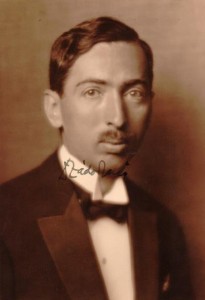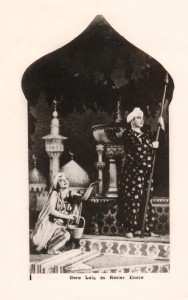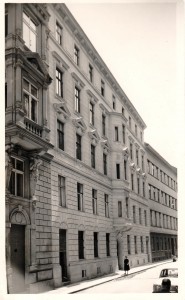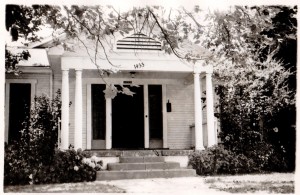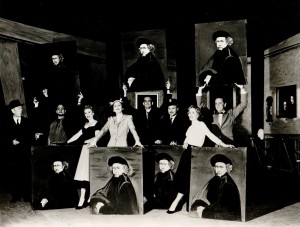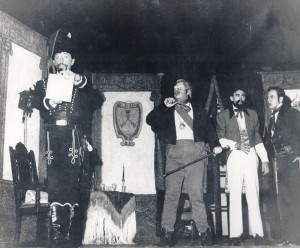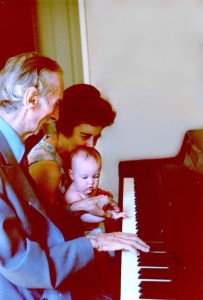Biography
Bátaszék
EUGENE ZÁDOR was born in the village of Bátaszék, Hungary, on November 5, 1894. His mother, Pauline Bierman, came from a German settlement in Bosnia, and his father, Josef Zádor (orig. Zucker), likely from Czechoslovakia. They were married in Bosnia, where they stayed a few years before settling in Hungary. According to Zádor, his parents were traveling across Hungary by horse-drawn wagon when the horse died in Bátaszék; there they stayed until 1900. “At first my father was a teacher,” Zádor wrote. “Later, when the family grew to include eight children, of which I was the seventh, Father looked for a more lucrative business and opened a small leather factory. When I was six, we moved to the city of Pécs.”
As he was walking home from school one day, young Zádor heard piano music coming from a neighbor’s house. He stood there listening for several hours in freezing weather. When he came down with pneumonia, his mother promised him anything if he would only recover. “And so it happened that the next day in our living room, there was a long, awful-sounding yellow piano with only five octaves, but it was a piano and it had keys. Not a bad attempt at blackmail for a six-year old.”
Zádor as Student
Zádor studied piano and composition at the Conservatory in Pécs. He described his first compositions, short pieces for piano, as influenced by Schumann and Verdi. “But when, in Budapest, I heard the work of Richard Strauss, I came under his spell and especially his orchestration, which had a magical effect on me.”
In an interview a half-century later, Zádor recalled a fond memory from his high school days in Pécs. “When the kind French teacher saw that I was composing in class, he stopped teaching until I had finished the piece. His son is now a cellist with the New York Philharmonic.”
In 1911, Zádor entered the Vienna Conservatory, where he studied composition with Richard Heuberger and also piano and organ. There he wrote his first orchestral composition, Jugendsymphonie, which was performed in Budapest when he was just seventeen. A year later, he continued his studies in Leipzig: musicology with Hermann Albert and Arnold Schering, and counterpoint with Max Reger. Zádor described Reger as a far better composer than a teacher and as the master of counterpoint. On one occasion, following a performance of one of Reger’s works at the Leipzig Gewandhaus, Zádor approached Reger and told him, “Maestro, your knowledge of counterpoint is amazing.” Reger replied, “There are only two great masters of counterpoint. The other is Bach.”
A collection of Zádor’s first piano compositions and counterpoint exercises is housed at the UCLA Research Library, Special Collections. These early works are dated ending in the spring of 1914.
Zádor was conscripted into the Hungarian army in World War I. He was issued a rifle and told to guard a bridge. About this assignment he said only that he was very cold. Two of his brothers were killed in action early in the war. When his mother received the news of their deaths – in a single letter – her grief was overwhelming. In light of his fallen brothers, he was released from duty along with his younger brother.
From 1915 until 1920, Zádor remained in Pécs where he wrote music criticism for a local newspaper. In 1918, he composed his first mature work, Bank Ban, a tone poem, which was performed in Budapest the following year. He wrote his first large orchestral piece, Variations on a Hungarian Folksong, in 1919; but it was not performed until eight years later, in Vienna. It was played again in 1928, this time by the Berlin Philharmonic, Wilhelm Furtwängler conducting.
In 1920, Zádor left Pécs to study musicology with Fritz Volbach at the University of Münster. He completed his doctorate in 1921; his dissertation was titled Wesen und Form der symphonischen Dichtung von Liszt bis Strauss (Character and Form of the Symphonic Tone Poem from Liszt until Strauss).
Zádor as Teacher
In 1921, Zádor settled in Vienna, where he became a professor of composition and orchestration at the Neues Wiener Konservatorium. By then, he had already written a dozen songs and piano pieces, several chamber works, and two symphonies. The first of his twelve operas, Diana, a Grand Guignol piece about a medieval knight, was premiered at the Budapest Royal Opera House in 1923. His second opera, Isle of the Dead (1928), was also produced at the Budapest Royal Opera House; its subject was the painter Arnold Böcklin.
As a professor, Zádor had a number of students who became very successful: Kurt Herbert Adler, Peter Paul Fuchs, and Thomas Martin among them. But the student he spoke about most often was Count Ferenc Esterházy, whose grandfather had been a patron of Haydn. “Times have changed,” Esterházy once told Zádor. “When Haydn came to the castle, he always had to come through the back door; you come through the front.” Zádor appreciated Esterházy’s patronage of the arts, but what endeared him most were the count’s flamboyant character and his antics. One example: when Esterházy held meetings, he often did so in the bathroom; a dozen people stood around while he soaked in the tub.
Vienna
Zádor wrote some of his most important and enduring orchestral works between the two world wars. His Variations on a Hungarian Folksong was well received when it was premiered in Vienna on February 7, 1927. Rhapsodie für grosses Orchester (1930), Kammerkonzert (1931), Symphonia Technica (1932) and Rondo for Orchestra (1933) followed and added to his stature as a composer. He was awarded the Hungarian National Prize in 1934 for his Piano Quintet.
1935 was a very important year in Zádor’s life. His Hungarian Caprice was premiered by the Budapest Philharmonic Orchestra, Carl Schuricht conducting. This work has been performed hundreds of times since, under such conductors as Stokowski, Ormandy, Monteux, Wallenstein, Szell, and Barbirolli; and there have been three recordings of it. 1935 was the year Zádor was awarded two honorary doctorates, one from the Royal Academy of Music in Budapest and one from the New York College of Music. It was also the year that Zádor met a young piano student, Maria Steiner, who would become his wife – but not until 1946.
In addition to his orchestral compositions of the period, Zádor wrote many songs, two ballets, Maschinenmensch and Jury, and three more operas: X-mal Rembrandt (1930), an opera-burlesque in one act dealing with a painter copying a self-portrait of Rembrandt, Dornröschens Erwachung (1931), a one-act retelling of Sleeping Beauty, and Azra (1936), a three-act opera about forbidden love. Azra proved to be Zádor’s greatest operatic success, enthusiastically received by audiences and critics, and performed many times at Budapest’s Royal Opera House.
As Zádor’s artistic output and reputation grew, he also prospered financially. He was able to buy the four-story building on Reinösselgasse where he lived. He also bought two cottages at Lake Balaton in Hungary, where his family gathered for summer vacations. Zádor’s niece, now in her nineties, remembers the summers at the Balaton as the happiest of times.
Zádor was well-connected in the music world. It seemed he knew everyone, but he held no one in higher regard than Béla Bartók:
“We saw each other when he came to Vienna. He always notified me when hecame. I waited at the station and we took a cab to his hotel. Bartók was simplicity itself, he didn’t like fancy hotels. On the contrary, where he stayed was an old, cheap hotel on the Wiedner Hauptstrasse, but he didn’t care; it was near to the Musikvereinsaal and to the Radio, where he performed…. Even more than his music, I admired his honesty, his unsophisticated human simplicity, and his uncompromising character.”
Years later, when they were living on different coasts in the United States, they kept in touch through letters. In one, dated July 1, 1945, shortly before his death, Bartók wrote about going back to Hungary, “How much I would like to go home, but forever.” The original of this letter is now in the Hungarian National Museum.
Zádor composed one more orchestral work while living in Europe, Dance Symphony (1937), which was performed in Vienna, Hans Knappertsbusch conducting. On March 12, 1938, the same day Germany annexed Austria, Zádor fled to Budapest, where he remained for about a year. He took few belongings with him. Maria Steiner went to his apartment, packed up the rest, and arranged for shipping. She was able to travel freely to visit him in Budapest and at the Balaton, but she knew it was only a matter of time before he left for America. She was heartbroken.
Zádor had received a written offer of employment from the New York College of Music. This job offer enabled him to obtain a visa. In later years, whenever he talked about leaving Europe, he always credited his mother with the difficult decision. “War is coming,” she warned, and urged him to go.
On March 25, 1939, Zádor boarded the Normandie at Le Havre and began the five-day voyage to New York. Among the manuscripts he brought with him was the score for a new opera, Christopher Columbus.
New York
In New York, Zádor rented a room on West 91st St. He supported himself teaching and working as an orchestrator for the Ford Sunday Evening Hour radio program. His first success as a composer came within months of his arrival; Christopher Columbus was given its world premiere on October 8, 1939. The German libretto had been written by Archduke Josef Franz, based on his play; the English translation was done by Josepha Checkova.
The performance came about by happy accident. Zádor had gone to a concert in the spring of 1939. At intermission, he accidentally stepped on a woman’s toe. He apologized and the two struck up a conversation. As it happened, she was the wife of the Hungarian conductor Ernö Rapée. Impressed by Zádor, she offered to introduce him to her husband.
In July, Zádor presented Christopher Columbus to Rapée, who accepted it after hearing only the first seven pages. The performance, in concert form, took place three months later at the Radio City Center Theater. Rapée conducted the NBC Orchestra, and the lead roles were sung by Robert Weede and Jan Peerce of the Metropolitan Opera.
In his letters, Zádor wrote that he had never had such a success, even in Vienna. The theater audience of two thousand had called him to the stage several times for bows. The performance was broadcast nationally and even transmitted via shortwave to Mexico and South America.
Although elated by the reception of Christopher Columbus, Zádor longed to return to Europe, if only for a short visit. For the first time in many years he had not been able to spend the summer at Lake Balaton. He dared not leave the US, however, fearing that if he did he would not be able to re-enter. Csárdás Rhapsody (1939) was an expression of his nostalgia for Hungary. He did not know it at the time, but it was also his farewell.
In December of 1939, Zádor’s Maschinenmensch Ballet Suite was performed by the Philadelphia Orchestra, Eugene Ormandy conducting; in February, 1940, his Rondo was played by the Philharmonic Symphony Society of New York, John Barbirolli conducting. Despite these successes, Zádor was worried about his future in the United States; he was struggling financially.
When he received an offer from MGM to compose music for films, Zádor took it. The pay was good, but there was no contract to guarantee a steady income.
Hollywood
Zádor arrived in California in early February, 1940. Describing Hollywood, he wrote in a letter, “How beautiful the mountains are and how warm the sun is… Here, people go in the ocean even in winter (not me).”
During 1940 and 1941, he wrote music cues for Florian, Gallant Sons, The Mortal Storm, Escape, Edison the Man, Third Finger Left Hand, and Rage in Heaven. Zádor “stock music” was later used in Reunion in France, Madame Curie, The Thin Man Goes Home, The Stratton Story, and The Devil Makes Three.
All of Zádor’s music for films is uncredited. The Mortal Storm is of particular interest in this regard. Film credit went to Edward Kane, who never existed. The score was actually written by Zádor and Bronislaw Kaper. Neither composer wanted his name used, as they each had family in Europe and feared for them, especially given the anti-Nazi storyline of the film. And so it was decided that “Edward” would be substituted for “Eugene” and “Kane” for “Kaper.”
Zádor enjoyed living in sunny Los Angeles, but the studio work was not easy. He often worked through the night. Deadlines had to be met, “otherwise you would be shown the door,” he said. He lived frugally in a small apartment near the studios. “Here, the drug stores are also restaurants. Have you ever heard of something like this?” he wrote in a letter. “I save a lot, live like a student, and if God wills, a year from now I won’t be poor anymore.” Indeed, by 1942 he was able to buy a three-bedroom house.
Between films, Zádor had time to compose for the concert hall: Children’s Symphony (1941, revised in 1960), Tarantelle (1942), and Tarantelle-Pastorale (1942).
Biblical Triptych (1943) was inspired by Thomas Mann’s novels, collectively titled Joseph and his Brothers. Zádor’s original intention had been to write a tone poem based only on Joseph, but over time he decided to add representations of David and St. Paul. The work was premiered by the Chicago Symphony in December of 1943 and was performed the following January by the San Francisco Symphony. Widely praised by the critics, it also impressed its most important listener, Thomas Mann:
“You have succeeded admirably in doing with musical tone that which I attempted to do with words, namely to unite primitive Oriental sound with modern sensibility and understanding. It is a real satisfaction for me to know that my story has inspired a master in the art which has ever been very dear to me, to create a work of such beauty and so full of the promise of permanency.”
Mann became a friend, and in 1948 was godfather to Leslie Thomas Gene Zádor.
When Biblical Triptych was performed in March of 1944 by the Philadelphia Orchestra, it was broadcast to Europe by shortwave radio. Zádor said in an interview that he hoped his parents in Hungary could hear it. He had been able to communicate with his family via letters and telegrams as late in the war as 1943. He assured them that he was well and having success. They too tried to be reassuring. “Don’t worry about us,” his father wrote, “we have everything we need.” Eventually their only communication was through the Red Cross.
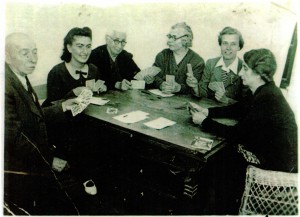
From left: the composer’s father, Josef Zádor; niece Lili; mother, Pauline Bierman Zádor; sister Ida Zucker; nephew’s wife Erzsi Engel; sister Marishka Engel
Soon after the war ended, Zádor learned that many of his family members had not survived. For decades he wore a black tie in their honor. If asked about it he would say, “For my parents.” He never talked about the circumstances of their deaths, nor did he want anyone else talking about it. He was adamant about this.
Maria Steiner had lived through the war in Vienna, and there were still many of Zádor’s family members remaining in Hungary. By this time, he had a contract with MGM and was earning good money as an orchestrator, while those he loved were doing without basic necessities. He sent many packages overseas – food, shoes, boots, stockings, gloves, coffee and cigarettes.
Zádor was able to reunite with Maria Steiner in November of 1946. Since he was not permitted to go to Vienna, nor she to the United States, they met in Geneva. There they married; the conductor Ernst Ansermet was a witness. Zádor gave his wife a piano piece he had written, Bagatellen in Jazz, inscribed with their wedding date. She had not played the piano since the war began and the piece was very difficult, but she learned to play it.
Zádor did not compose again until 1954. MGM was keeping him very busy orchestrating Miklós Rózsa’s film scores. He was consumed with helping family members immigrate to the United States. This was also a time when he took on a private student, actor Lionel Barrymore.
Barrymore came to Zádor’s home for lessons in composition five days a week. He was an enthusiastic student who showed talent. Zádor wrote about him in an article:
“The honk of his horn would announce his daily arrival… in his old Oldsmobile. Sometimes he would stay in the car and we would sit and talk – music first then many things – he drinking beer I always had ready for his arrival. But when he greeted me with ‘Here, Gene, take this,’ and shoved a manuscript onto the tray of beer and cookies, and opened the door and whipped out his crutches, then I knew that he had been up all night composing…. Just as when he listened to great music, so when I would play his latest efforts, a great smile would light up his face…. ‘You see,’ he would say, ‘in spite of the fact that I wrote it, it’s good.’ And more often than not, it was.”
Barrymore became a close friend and remained Zádor’s student for ten years.
1950s
By 1950, Zádor’s household had grown to six. A son, Leslie, and a daughter, Peggy, had been born, and Maria Zádor’s parents had come from Vienna. By the mid-fifties, three nieces and their families had also settled in Los Angeles; Zádor’s younger brother and his wife were the last to emigrate, in 1956. Many decades later, a great-niece aptly described Zádor as “the glue that held the family together.”
Despite a heavy schedule orchestrating films scores, Zádor again found time for composition. His Elegie and Dance (1954) was premiered by the Los Angeles Philharmonic, Alfred Wallenstein conducting, and was also performed by the Philadelphia Orchestra. In 1955, X-Mal Rembrandt, re-titled Forever Rembrandt, was translated into English and performed at UCLA, Jan Popper conducting. In his review of the opera in the Los Angeles Times, Albert Goldberg wrote, “The principal interest lies in the orchestral score, which constantly bristles with a sort of Straussian activity, harmonically piquant and set for the instruments in a sparkling manner.” Another work, Divertimento for Strings, which had been commissioned by Nikolai Sokoloff, was introduced at the La Jolla Festival in July 1955. The Divertimento became one of Zádor’s most frequently performed compositions.
Zádor’s Fugue Fantasia (1958) received its premiere in Australia, Tibor Paul conducting. Zádor described it in the program notes: “It is a short work suitable to opening a concert. The introduction leads to a regular fugue on a chromatic theme. Later, it becomes a fantasia, when greater liberties are taken, detouring into other themes and developing them independently. Contrapuntal episodes contrast with free melodic lines.” When Isler Solomon conducted the Fugue Fantasia at the Hollywood Bowl, Albert Goldberg wrote a positive review and noted the “unusually enthusiastic applause of an audience that is not supposed to like new music.”
1960s
In his youth, Zádor had been a doting uncle, and in middle age he became a loving, generous and protective father. When his children were small, he made up stories about a righteous giant named Goliath, who always arrived just in time to save the day. In 1960, he rewrote an earlier Children’s Symphony, which he dedicated to Leslie and Peggy. Describing this new version, Zádor wrote:
“The Children’s Symphony is a reminiscence of my childhood impressions, and all but the first movement are treated in programmatic style…. The second movement, entitled ‘Fairy Tale,’ recalls the nursery stories told me by my grandmother…. The third movement, ‘Scherzo Militaire,’ pays tribute to my toys, the little tin soldiers…. The last movement is a scene on the farm…. We hear the barking of dogs, the mooing of cows, the crowing of a cock, and the quacking of ducks.”
Three years later, Zádor wrote another work for children, The Remarkable Adventures of Henry Bold. This piece, with narration in rhyme, tells the story of a boy who magically travels the world. In a Santa Barbara New Press review, Daniel Wieder wrote, “The children in the audience chuckled and laughed. And they warmly applauded the narrator, the orchestra and the surprise visit of Zádor, the tall, slim, graying composer, who apparently also had fun.” Both the Children’s Symphony and Henry Bold were performed many times.
Zádor’s Elegie (1960) and Rhapsody (1962) were inspired by Hungarian folksongs and dances. Elegie was given its world premiere by the Philadelphia Orchestra. The program notes described the music as “generally in a quiet and elegiac mood, but in the course of its development it reaches dramatic levels, only to return to the nostalgic mood of the beginning.” Rhapsody, dedicated to Miklós Rózsa, was premiered by the Los Angeles Philharmonic, László Somogyi conducting. In his review, Goldberg noted, “The compliment of one Hungarian composer to another, conducted by a third, was, as one might expect, in the Hungarian folk style, although the material is original. It is an enjoyable and entertaining work, free-wheeling, melodious, harmonically rich and zesty, and lushly orchestrated.”
In 1961, Zádor composed Suite for Brass and Christmas Overture. The following year, his Ode to Peace was played by the Miami Symphony, Fabien Sevitsky conducting. This work, which had been a commission, was dedicated to the United Nations.
As he neared his seventieth birthday, Zádor retired from MGM. Early in his tenure in Hollywood, he had switched from film composition to orchestration, which he could do from home and which he found a less pressure-inducing role. He considered himself fortunate to have paired up with a first-rate composer for the concert hall, chamber ensemble, and film, Miklós Rózsa, whose abilities Zádor trusted and respected. Rózsa was also pleased to have found an orchestrator who was competent and reliable; and when Rózsa signed his first contract with MGM in 1948, he included a clause that insured he would be able to continue to work with Zádor. Rózsa would typically submit four-line scores to Zádor, who was able to articulate precisely whatever the composer wanted in fleshing them out into full orchestral scores. When, for example, Rózsa was working on Ben-Hur in Rome during 1959, he would airmail the materials to Zádor, who worked quickly and efficiently so that he could deliver the completed conductor’s score to MGM where staff copyists produced the parts. (Once the filming of Ben-Hur at Cinecittà Studios outside Rome was complete, Rózsa returned to the U.S. and recorded the music at MGM Studios in Culver City.) Their work together on El Cid two years later followed a similar format. Rózsa composed the music in Madrid and mailed it to Zádor in Hollywood. It was a good working relationship that lasted 22 years.
Zádor regarded his work as an orchestrator for the most part as a way of making a living while pouring his creative energies into composing his own music. There were, however some notable exceptions – films that Zádor, who loved history, considered important motion pictures to which the music had made a substantial contribution and with which he was proud to have been associated, among them: Quo Vadis, Julius Caesar, Lust for Life and, above all, Ben-Hur.
By 1963, Zádor had orchestrated over a hundred film scores, including three that won Academy Awards for best music: Spellbound, A Double Life, and Ben-Hur. He had invested his earnings wisely and no longer needed the income from the studios. Now, he would have more time to compose and travel.
In the summer of 1964, Zádor took his family on an extended trip to Europe. He met with conductors, publishers, and old friends in Vienna and Zurich. Rózsa gave the family a tour of Rome; in Bologna and Rijeka, Maria Zádor reconnected with childhood friends. During the trip, they received excellent news: Zubin Mehta had put Zádor’s Festival Overture on the program for the opening week of the new Los Angeles Music Center. Mehta conducted it on December 10, 1964.
In January 1965, Ormandy conducted the Philadelphia Orchestra in the world premiere of Zádor’s Five Contrasts for Orchestra. In his review in The Philadelphia Inquirer, Daniel Webster wrote, “Zádor is a composer of more than usual wit, and his five concise sections were alive with spirit, humor, and a sardonic strain not unlike that of his countryman Bartók.”
Zádor composed Variations on a Merry Theme and Dance Overture in 1965, Suite for Eight Celli in 1966, and Celebration Music in 1967. Aria and Allegro (1967) proved to be one of Zádor’s biggest successes. Hans Schmidt-Isserstedt introduced the work in a performance by the Los Angeles Philharmonic at the Music Center and then took it on tour with the orchestra. István Kertész conducted it at Lincoln Center in April, 1969. Zádor described the piece this way: “The aria offers a melody accompanied by a vertical combination of chords, which gives the harmonization an almost bi-tonal character. This is followed by the allegro, which is a rondo in structure, the main theme heard four times.”
Beginning in the 1960s, Zádor again wrote for voice. His choral works include Cantata Technica – Scherzo Domestico (1961), Three Rondells (1962) and Triptych for Mixed Chorus (1965). His one-act opera, The Virgin and the Faun (1964), about a family forced to sell its prized possession, was performed at UCLA. The Magic Chair (1966), a one-act comic opera about a bureaucrat who must tell scandalous truths, was performed in Baton Rouge. The Scarlet Mill, a two-act opera about devils corrupting an innocent man, was performed at Brooklyn College in 1968 and again at UCLA in 1974.
Zádor began writing solo pieces for what he called “underprivileged instruments.” His Trombone Concerto, the first of many such pieces, was first performed in 1967 by the Detroit Symphony, Sixten Ehrling conducting. Rhapsody for Cimbalom and Orchestra followed in 1969.
1970–77
Old age did not slow Zádor down. He continued to tell wonderful stories, to make jokes, and to compose music. As he had done all his life, he took long daily walks. Tall and rail-thin, he was a striking figure in the neighborhood. He wore a three-piece suit every day and always put on a hat when he went outdoors; if the weather was the least bit cold he wore an overcoat. Wherever he went, he had paper and pencil in his pockets, so that if a musical idea came to him at any time, he was ready to jot it down.
In the 1970s, Zádor wrote many additional works for under-privileged instruments: Fantasia Hungarica (for double bass, 1970), Music for Clarinet and Strings (1970), Accordion Concerto (1972), Suite for Horn, Strings and Percussion (1972) and Oboe Concerto (1975). Duo Fantasy (for two celli, 1972), was recorded by the father-son team of Gábor and Peter Rejto.
Zádor considered Studies for Orchestra (1970) to be among his finest orchestral works “in that it has the most color.” As he explained, “I wanted to show all the possibilities of the orchestra. A flute has a high C and nobody ever uses it, and a contrabassoon has a low B flat and nobody uses it. But I used them, because if they weren’t usable, they wouldn’t be there.” Zádor attended the premiere of Studies for Orchestra in November 1970, in Detroit, with Sixten Ehrling conducting the Detroit Symphony. The following year, the Studies were performed in Los Angeles under the baton of Elmer Bernstein, the composer of such outstanding film scores as The Man with the Golden Arm, The Magnificent Seven and To Kill a Mockingbird.
By this time, Zádor had almost forgotten about a three-act opera he had written in 1928: The Inspector General, based on Gogol’s play. He had had it translated into English by George Mead in 1940, but had done nothing about it since then. When asked for a new work by the conductor of the West Coast Opera, Zádor remembered The Inspector General, which he described as “the story of a nation told through satire.” After extensive revisions to the score and libretto, the opera was performed in Los Angeles in 1971.
Zádor wrote suites for woodwind quintet in 1972 and brass quintet in 1973. The Quintet for Brass was recorded along with Studies for Orchestra. In his record review in the New Yorker, Winthrop Sargeant wrote about Zádor:
“His style of composition, which reminds one of Bartók, is non-serial and easy to take, and he is given to elaborate but tightly knit forms and extraordinarily imaginative orchestration. Studies for Orchestra and Quintet for Brass, played respectively by the Westphalian Symphony Orchestra… and the Modern Brass Quintet of Los Angeles… are fine examples of his work.”
Sargeant called Zádor “one of the most important composers to come out of Hungary since Béla Bartók.”
In 1974, Zádor wrote one more opera, Yehu, a Christmas Legend. The same year, he wrote The Judgement (for three soli, women’s chorus, brass and percussion), and in 1976 he composed his final work, Cain, a melodrama for baritone and orchestra.
At eighty, Zádor became a grandfather, which made him tremendously happy. He dedicated his Oboe Concerto, Yehu and a short orchestral work, Hungarian Scherzo (1975), to his granddaughter, Sabrina, born in 1975. When he first saw his grandson, Peter, born in 1976, he said, “He looks like me,” then went home and wrote a lullaby.
Though ill and frail, Zádor was able to attend a performance of the Hungarian Scherzo. Daniel Cariaga, writing for the Los Angeles Times, called this composition “a work of undeniable, even irresistible charms.”
In his final days, Zádor reminisced about Esterházy and Barrymore. He talked about how he had met his wife, and how he had come to the United States and landed a job at MGM. The loss of family members in two world wars had been profoundly sad, but Zádor remained an optimist. He was proud of his career in music and pleased to have made a good living in his adopted country: “I came to America with three dollars in my pocket. Imagine if I would have had five dollars, or ten!”
After Zádor’s death on April 4, 1977, his son Leslie published Eugene Zádor, a Catalogue of his Works and sent copies to people who had known his father. He received many letters of thanks, including this one from Winthrop Sargeant:
“Thank you for the copy of the brochure about your father’s work. I did not write to you at the time of his death, but I was greatly saddened by it. I remember the time when he came to my office at Time magazine, an impoverished refugee asking my advice. I had two tickets to a Rachmaninoff recital that evening, and I offered him one of them. He was delighted to go with me, and we both enjoyed the playing of the great pianist. I also said to him, ‘Go to Hollywood. That’s where they need composers.’ And he did, and became a big success. I always liked his music as you know, and am sorry the world has lost a composer of his stature.”
Zádor was survived by his children, his grandchildren (another granddaughter, Lily, was born in 1982), and by his wife who lived to the ripe old age of 97.
References
Ewen, David, ed. Composers Since 1900. New York: H.W. Wilson, 1969. 633-635.
—. The World of Twentieth Century Music. Englewood Cliffs, NY: Prentice Hall, 1968.
Slonimsky, Nicolas. Baker’s Biographical Dictionary of Musicians. 6th ed. New York: Macmillan, 1978. 1933-1934.
—. Music Since 1900, 4th ed. New York: Schribner’s Sons, 1971.
Tovey, Donald Francis. Essays in Musical Analysis vol. VI. London: Oxford University
Press, 1939. 100-102.
Zador, Leslie. Eugene Zádor, A Catalogue of His Works. San Diego: Music Graphics Press, 1978

